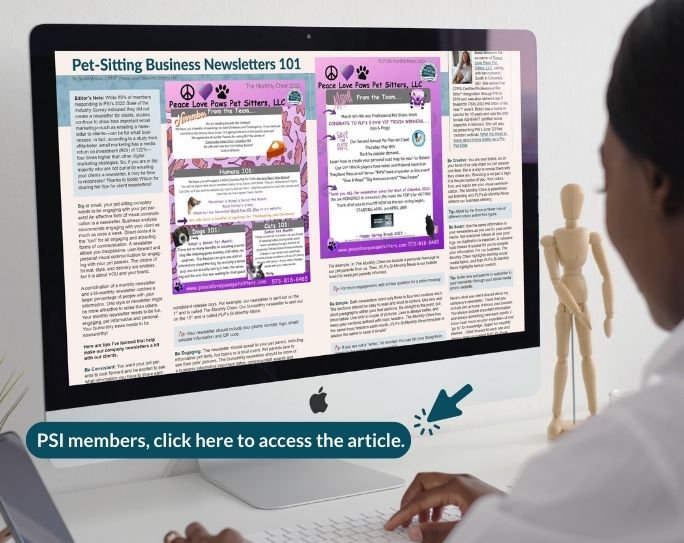Why Pet Sitters Should Send E-Newsletters
By Beth Stultz-Hairston, PSI President
According to PSI’s recent State of the Industry Survey, 71% of PSI pet sitters use Facebook to promote their pet-care businesses. 41% indicated they use Instagram to advertise their services. But only 14% indicated their company published a company newsletter. Of these, 13% sent an e-newsletter (by email) and 1% printed a newsletter to mail or leave-behind for clients.
Looking at this data, you may be thinking “Newsletters must not be that important.”
But consider this: What would you do if you suddenly didn’t have access to Facebook or Instagram?

We’ve heard from members who have been locked out of their business accounts, had their pages disappear or had their accounts hacked. In addition to these possible issues, the fact is that none of us owns Facebook or Instagram, and we also can’t control their algorithms.
Should you use social media to promote your pet-care business and engages with your clients? Absolutely! Should you put all your eggs in that basket? Absolutely not!
Gathering client (and prospective client) email addresses allows you to build a marketing list that you maintain—and allows you to control the information you send to them.
Best practices for your e-newsletter
Creating and sending a regular e-newsletter to your email list offers a great opportunity to stay top of mind with local pet parents, provide valuable pet information (which helps establish you as a trusted resource) and promote your services.
Before you send out your first email, though, keep these best practices in mind:
Determine your audience. Will you send your newsletter to clients only, or will prospective clients be able to sign up to receive your newsletter as well? You also want to give thought to your specific audience and what type of information will benefit them. The good news is that you know your clients! You know their pets (and any special concerns), you know their travel habits, you know their work habits, etc. This “inside information” can help you determine what content to include in your newsletter that will make your audience actually want to read what you’re sending! Remember, while your ultimate goal with your e-newsletter may be to increase your business, the primary focus of your emails should be to provide information that will benefit your audience!
Pick a schedule and stick with it. As a pet sitter or dog walker, you are dependable and consistent. Your newsletter should be the same! Whether you decide to send your newsletter weekly, monthly, or quarterly, pick a publication schedule and stick with it. Your clients should know when to expect your newsletter. For example, PSI’s e-news to members goes out every Monday morning. Establishing a consistent e-newsletter schedule ensures your clients know when to expect communications from you—and helps you better plan your workload!
Focus on worthwhile content. While you may be tempted to just pull together a list of pet-related articles you find online for your e-newsletter, it’s important to be intentional about what you choose to include in your emails. During her session at a previous FOCUS One-Day Online Summit for Pet Sitters and Dog Walkers hosted by PSI, Tori Mistick explained that your content should fit into one of four categories—it should educate, entertain, engage, or inspire. She also reminded participants that the copy they use (for e-newsletters, social-media captions, etc.) should help increase their “like, know, trust factor” with their audience.
Remember, too, that your newsletter shouldn’t simply be a sales pitch. Many experts recommend the 90/10 rule, which means that only 10% of your communication should be promoting your business; the other 90% should be educational for your audience. It’s also important to proofread to ensure your content is as error-free as possible. You don’t want spelling or grammar errors to distract your audience from the great information you shar sharing!
Other tips to keep in mind
Another good rule of thumb to keep in mind is to have one clear call-to-action in each email. This call-to-action will vary, depending upon the email. For example, you may want them to click-through to read a blog post on your website or watch a video tutorial you’re sharing that shows them how to book visits using your software. Because everyone is busy—and most readers have short attention spans—it’s a good idea to only focus on one call-to-action per email. This is why sending a shorter weekly email may be a better option than sending a long monthly email.
Measuring your results is essential. Track your open rates for your emails and look to see if certain subject lines result in a higher open rate. Check your click-through rates on your call-to-action to see if you can determine any trends in what causes your readers to click or not. Also be mindful of unsubscribes and opt-out requests. If you find many clients are opting out of receiving your emails, you’ll need to take a closer look at the value of what you’re sending.
Improving your e-newsletter will be an ongoing process as you learn what your audience responds to most. It may seem daunting at first, but you’ll soon find that regularly delivering beneficial content is a win-win for your clients and your business!
PSI members, for additional tips click the image below to read Pet-Sitting Business Newsletters 101, an article written by PSI member and 2024 Pet Sitter of the Year Bobbi Wilson, which was included in a 2023 issue of Pet Sitter's World magazine.








Comments
No comments.